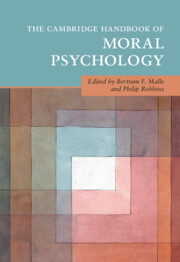Book contents
- The Cambridge Handbook of Moral Psychology
- Cambridge Handbooks in Psychology
- The Cambridge Handbook of Moral Psychology
- Copyright page
- Contents
- Figures
- Tables
- Contributors
- Preface
- 1 Modern Moral Psychology
- Part I Building Blocks
- Part II Thinking and Feeling
- Part III Behavior
- Part IV Origins, Development, and Variation
- Part V Applications and Extensions
- Index
- References
Part II - Thinking and Feeling
Published online by Cambridge University Press: 20 February 2025
- The Cambridge Handbook of Moral Psychology
- Cambridge Handbooks in Psychology
- The Cambridge Handbook of Moral Psychology
- Copyright page
- Contents
- Figures
- Tables
- Contributors
- Preface
- 1 Modern Moral Psychology
- Part I Building Blocks
- Part II Thinking and Feeling
- Part III Behavior
- Part IV Origins, Development, and Variation
- Part V Applications and Extensions
- Index
- References
- Type
- Chapter
- Information
- The Cambridge Handbook of Moral Psychology , pp. 151 - 270Publisher: Cambridge University PressPrint publication year: 2025

